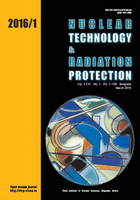
A STUDY ON THE USE OF THE REACTOR BASIC EXPERIMENTS IN THE U-D2O LATTICES OF THE RB CRITICAL ASSEMBLY FOR VALIDATION OF MODERN NUCLEAR DATA LIBRARIES
Pages: 1-15
Authors: Milan P. Pešić
Abstract
Demand on the availability of well-defined reactor experiments for validation of computer codes for use in nuclear industry and nuclear technology is everlasting. Users must be confident of the results obtained by the proven computer codes and nuclear data libraries chosen in the models. The well-defined (mostly historical) and evaluated reactor experiments (about 5000 in 2015) were collected continuously as the benchmarks within the frame of the OECD/NEA international projects ICSBEP (since 1995) and IRPhEP (since 2003). The Handbooks of the Projects are published in electronic forms (at the NEA web site of the OECD and at a DVD media) every year. This study is aimed to (a) examine and evaluate reactor basic experiments, carried out in the lattice of the natural uranium metal fuel in the heavy water of the RB critical assembly first core in 1958, and (b) demonstrate their possibility for validation of modern nuclear data libraries. These RB reactor basic experiments include: (1) approach to criticality, (2) determination of the reactivity gradient at the D2O critical level, (3) measurement of the dependence of the D2O critical level on the D2O temperature, i. e. dependence of the reactivity with change in the D2O temperature; (4) the critical reactor geometrical parameter (buckling) measurements, (5) the migration length measurements, (6) determination of the neutron multiplication factor in the infinite lattice, and (7) the safety rods reactivity measurements. Results of the experiments are compared to the results obtained using modern nuclear data libraries of the ACE type by applying the MCNP6.1, a well-known and proven computer code based on the Monte Carlo method. A short overview of these experiments (done at the RB assembly) is shown. A brief description of the neutron ACE type nuclear data libraries (created in the LANL, based on the ENDF/B-VII.0 and ENDF/B-VII.1 files, or created in the OECD/NEA, based on the JEFF-3.2 evaluated nuclear data files), used in this validation study, is given. The benchmark models used for this validation study are described and the obtained results were analyzed. It is concluded that most of these reactor basic experiments, carried out in the lattice of the natural uranium metal fuel rods and the heavy water of the RB critical assembly, can be used as the benchmarks for validation of new nuclear data libraries. It may be done after further evaluations of influence of missing data, information and uncertainties in the material composition and geometry dimensions have been prepared according to the IRPhEP criteria and standards.
Key words: RB reactor, U-D2O reactor experiment, MCNP6.1, nuclear data library, validation, IRPhEP
FULL PAPER IN PDF FORMAT (2.85 MB)
